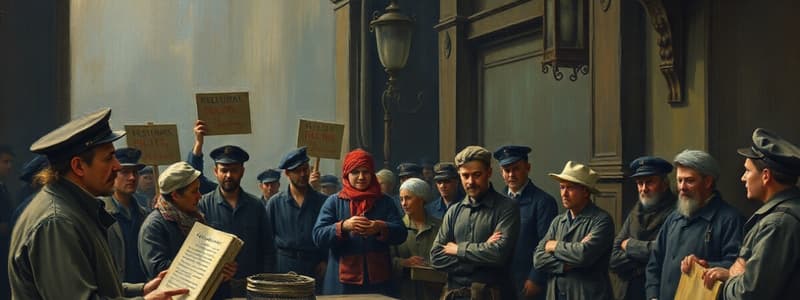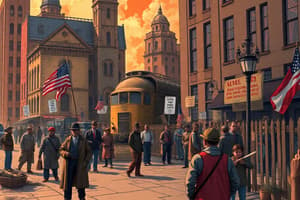Podcast
Questions and Answers
What was one of the earliest types of labor unions to emerge in the 1800s?
What was one of the earliest types of labor unions to emerge in the 1800s?
- Craft unions (correct)
- Agricultural unions
- Industrial unions
- Service unions
What significant ruling did the Massachusetts Supreme Court make in Commonwealth v. Hunt?
What significant ruling did the Massachusetts Supreme Court make in Commonwealth v. Hunt?
- Declared strikes illegal
- Allowed labor unions to organize legally (correct)
- Banned child labor
- Established minimum wage standards
Which organization aimed to unify all workers and advocate for broad social reforms?
Which organization aimed to unify all workers and advocate for broad social reforms?
- Knights of Labor (correct)
- United Mine Workers
- American Federation of Labor
- Teamsters Union
Which event is known for the violent clashes that emerged due to a nationwide strike in 1877?
Which event is known for the violent clashes that emerged due to a nationwide strike in 1877?
What was one of the primary goals of labor unions in the 1800s?
What was one of the primary goals of labor unions in the 1800s?
What challenge did early labor unions face regarding public perception?
What challenge did early labor unions face regarding public perception?
Which labor organization primarily focused on representing skilled laborers?
Which labor organization primarily focused on representing skilled laborers?
What legacy did labor unions leave by the end of the 1800s?
What legacy did labor unions leave by the end of the 1800s?
Flashcards are hidden until you start studying
Study Notes
Overview of Labor Unions in the 1800s
- Definition: Labor unions are organizations of workers formed to protect their rights and interests, primarily concerning wages, working conditions, and benefits.
Key Developments
-
Early Formation:
- The first labor unions emerged in the late 18th century but gained momentum in the 1800s.
- Craft unions, representing skilled workers (e.g., carpenters, printers), were among the earliest.
-
Important Strikes:
- The Lowell Strike (1834): Feminine laborers protested wage cuts in textile mills.
- The Great Railroad Strike (1877): Nationwide strike due to wage cuts by railroad companies, leading to violent clashes.
-
Legislation and Legal Challenges:
- Commonwealth v. Hunt (1842): Massachusetts Supreme Court ruling allowed the legality of labor unions.
- Early unions faced legal challenges, often being seen as conspiracies against business.
-
Formation of National Organizations:
- Knights of Labor (1869): Aimed to unify all workers and advocated for broad social reforms, including the 8-hour workday.
- American Federation of Labor (AFL) (1886): Focused on skilled labor; emphasized collective bargaining for better wages and working conditions.
Goals and Objectives
- Improving Working Conditions: Campaigns for safe workplaces and reasonable hours.
- Wage Increases: Efforts to secure higher pay relative to the cost of living.
- Job Security and Stability: Advocated against arbitrary dismissals and promoted employment stability.
Challenges Faced
- Opposition from Employers: Many employers resisted unionization, fearing loss of control and profits.
- Public Perception: Early unions were often viewed as radical or associated with strikes and violence.
- Internal Divisions: Differences in goals and tactics among various unions made unified action difficult.
Legacy
- Contribution to Labor Rights: Labor unions laid the groundwork for future labor rights movements.
- Institutional Recognition: By the end of the 1800s, unions began gaining more respect, leading to eventual legal reforms and negotiations with employers.
Conclusion
Labor unions in the 1800s were pivotal in initiating the labor rights movement, addressing crucial issues like wages, working conditions, and workers' rights, setting the stage for future advancements in labor legislation.
Labor Unions in the 1800s
- Labor unions are organizations formed by workers to advocate for their rights and interests, primarily wages, working conditions, and benefits.
- Early labor unions, primarily composed of skilled workers, started forming in the late 18th century, gaining momentum during the 1800s.
- Craft unions, representing skilled workers like carpenters and printers, were among the pioneering unions.
- The Lowell Strike of 1834 saw female textile mill workers protesting wage cuts, highlighting the early role of unions in addressing worker grievances.
- The Great Railroad Strike of 1877, a nationwide strike triggered by wage cuts, led to violent clashes, demonstrating the potential for widespread unrest stemming from labor disputes.
- The Commonwealth v. Hunt (1842) ruling by the Massachusetts Supreme Court affirmed the legality of labor unions, marking a turning point in their legal recognition.
- Despite the legal recognition, early unions faced challenges and were often viewed as conspiracies against business interests.
- The Knights of Labor (1869), a broad-based labor organization, aimed to unite all workers and advocate for social reforms, including the eight-hour workday.
- The American Federation of Labor (AFL) (1886), focused on skilled labor, emphasized collective bargaining to achieve higher wages and improved working conditions.
- Labor unions advocated for safer working environments and reasonable work hours to improve working conditions.
- Unions fought for higher wages that were commensurate with the cost of living, ensuring workers could adequately support themselves.
- Job security and stability were key objectives, as unions sought to protect workers against arbitrary dismissals and promote steady employment.
- Employers often resisted unionization due to concerns about loss of control and profits, leading to conflict between labor and management.
- Public perception towards unions was often negative, associating them with radicalism, strikes, and violence.
- Internal divisions within the labor movement, driven by differences in goals and tactics, hampered unified action and collective bargaining efforts.
- Labor unions played a pivotal role in shaping the foundation for future labor rights movements.
- Towards the end of the 19th century, unions began gaining more respect and recognition, setting the stage for subsequent legal reforms and negotiations with employers.
- The labor movement of the 1800s marked a critical moment in challenging unfair working conditions, advocating for workers' rights, and laying the groundwork for future advancements in labor legislation.
Studying That Suits You
Use AI to generate personalized quizzes and flashcards to suit your learning preferences.




